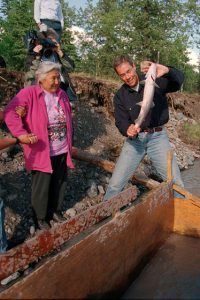Biographical Timeline | Leadership Qualities | ND Voting Rights |References
Katie John (Athabaskan)- Biographical Timeline
Katie John (Athabaskan) – Leadership Qualities
Biographical Timeline | Leadership Qualities | Atlantic Salmon | References
Strong-Willed

Strong-Willed is great word to use to describe Katie John. She was raised in an environment that many would not be able to withstand. Substance living is arguably one of the best ways for both personal health and the health of the planet. However, substance living requires strong people because it is not easy.
She learned English as a teenager. Learning a new language past the age of ten is proven to be far more difficult than when a child. She was married young and raised so many children. She then helped create a written alphabet for the language that she was raised with. Part of her being strong-willed is the will to keep her language alive, while so many factors of western culture is trying to erase it.
To credit her will once again, she started a court case to have Alaska state permit substance fishing. She was determined and fought for this for the remainder of her life. A huge part of her culture and the way she was raised is substance living. Once again Western culture tries and eliminate an indigenous culture, Katie John saw it as her duty to keep her language and way of living still going.
Frank
John did not mince words, beat around the bush, or play games. Throughout her life, she spoke plainly and directly about the issues she fought for and against. It did not matter who you were, what your status was, or what you thought of her, Katie John just told you what she thought. This was apparent in her leadership in Mentasta Village, where she once told her own son and other tribal members that they had to leave the village for a certain amount of time, and could not come back until they changed their ways.

Further, when she went to the Supreme Court to fight for substance rights, she did not change the frank way in which she talked, and in fact, seemed to utilize it as a way to break through the formal barriers of the court. After the court case had been determined in favor of her and the tribe, then Governor Tony Knowles could have appealed on behalf of the state of Alaska, and she simply invited him to their fish camp, which was illegal at the time. They spent the day together, and she spoke in her frank manner about the importance of fish to her people and their way of life. However, this is not to say she spoke with humor, or without intelligence, and when the Governor accidentally let a fish fall back into the river, she asked if he had granted it a “gubernatorial pardon.”
Determined

Being that Katie John was well known for obtaining rights for her people, it is clear to see that this job was not easy. Challenges she faced, especially that of being a Native woman, come to show how determined she was when standing up for what she believed in. Katie John knew well what things to take in consideration that would potentially be both positive or negative, but did not let that stop her from reaching her goals.
Katie received many rejections over the period of years in which she fought for her and her peoples rights, that including the one towards the Alaska Board State of Fisheries. This movement that began in 1985 by Katie herself, continues up to this day, even after her passing. This comes to show that although what she fought for was what she believed to be their rights, she was determined to do this not only for the period of time in which she lived, but for the future of her people. Despite many obstacles Katie faced while trying to obtain their rights, she did it all with love and honor and did not stop fighting up until her last days, making her a very respected Native American woman.
